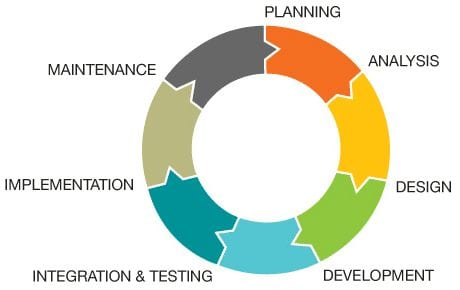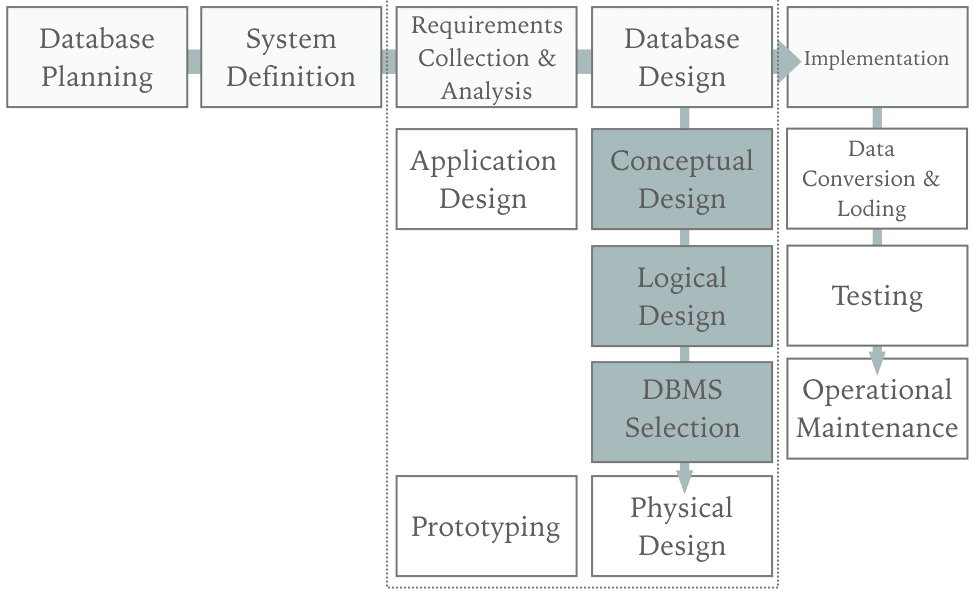A long-standing concept in the vast world of IT, a system development life cycle, or SDLC, is an iterative process that encompasses various activities that constitute the development of a structured information technology system. This term has been around for many decades and comes from a time when organizations were much more centralized. Still, as IT has been evolving as a field, and IT services as a market, an SDLC has become an important part of how companies build their software solutions.
This post is a comprehensive analysis of a system development life cycle. By reading it, you will learn what an SDLC is, its stages, advantages and disadvantages, as well as why it is important.
Let’s start.
What Is System Development Life Cycle
A system development life cycle (SDLC) is a structured project management model that outlines the phases required to build an IT system, from inception to the final result. The aim of a system development life cycle is to enable effective production of a high-quality solution that would meet or exceed a client’s expectations throughout all its stages, within the given budget and timelines.
7 Stages of System Development Life Cycle
A system development life cycle is a conceptual process that explicitly breaks down the stages required to develop and implement a system. Each stage plays a significant role in the development and differs from others in complexity, required assets, and expected functionalities.
Let’s take a look at these stages further.
System Development Life Cycle Phases
There are seven phases in a system development life cycle:

Now, let’s discuss each of them separately.
1 — System Development Life Cycle: Planning
Planning is the most crucial stage of the SDLC process. It involves identifying and defining the project scope to determine a comprehensive action plan for the project, and pinpointing the issues the solution it would resolve. This phase outlines what will happen throughout the entire life cycle, and determines the success of the entire project. Team structure, timeframe, budget, security, and other fundamental factors should be accounted for at this stage.
2 — System Development Life Cycle: Analysis
The planning is finished and the team is in place. Now, the team needs to perform an analysis of the system’s functional requirements to ensure it will meet the expectations of the target audience. Those expectations are then finalized and documented. The next step is performing a feasibility study to ensure that a system makes sense from financial, technological, and organizational standpoints.
3 — System Development Life Cycle: Design
Once the analysis is over and the requirements are set in stone, the design phase begins. This phase describes how to approach the design of a system’s architecture, user interface(s), network, databases, and security so that they will satisfy the requirements and enable future updates.
4 — System Development Life Cycle: Development
The development marks the end of the preliminary part of the process and signifies the beginning of the production. Then, software engineers write code and fine-tunes the technologies involved in the project (this can also include hardware, for example if an IoT project is in question). This is probably the busiest stage of the life cycle, as it involves a lot of hard work from all the experts involved in it.
5 — System Development Life Cycle: Testing And Integration
This phase involves testing and integration of the system and all related procedures to assess if it performs as expected and fully delivers on the requirements. The quality assurance (QA) team is responsible for this phase.
6 — System Development Life Cycle: Implementation And Release
At this stage, the new system is rolled out to the production environment, replacing the old one. This stage is performed by moving new data and components to where the old system was. After the implementation, the system is available to end users.
7 — System Development Life Cycle: Maintenance
After the release, any software system enters the stage of continuous maintenance. Today, any software product needs to be frequently checked for bugs and updated with features big and small. Indeed, you product may perform well upon release, but bugs can arise anytime. As for updates, your software solution needs to adapt to quickly changing needs its end users.
System Development Life Cycle Models
Further, we will look at two different and most popular SDLC models, and one sub-model — Waterfall, Agile, and data system development life cycle, respectively. Each comes with its pros and cons that must be weighed to make a solid decision.
Waterfall Model System Development Life Cycle
One of the oldest SDLC models, the Waterfall model is a linear, sequential approach that is popular in IT product development; it emphasizes the need for consistently advancing from one stage to the next one. Each stage must be fully completed before proceeding to the next; after the stage is finished, it cannot be revisited.

The Waterfall model is composed of these non-overlapping stages
Pros:
- Simple to understand and follow
- Clear milestones and deadlines
- Clear documentation
- Reinforces good coding habits
- Provides a solid structure
Cons:
- Unsuitable for complex or object-oriented projects
- Highly inflexible to scope changes
- Difficult to estimate time and budget precisely
- A working product emerges only on later stages of the cycle
Agile System Development Life Cycle Methodology
Being a dynamic and interactive framework, Agile has replaced the Waterfall system development life cycle methodology and became a significant driving force behind software development in the vast majority of companies across industries. This approach produces many release cycles where each iteration is tested, issues are addressed, and feedback is obtained from stakeholders throughout the process. It involves evolutionary development, continuous improvements, and flexible in the face of any changes.

Pros:
- Enables fast development and testing
- Issues are detected and fixed quickly
- Accommodates changes or enhancements
- Face-to-face communication and continuous feedback
- Less emphasis on design and documentation
- Scalability
Cons:
- Employees need prior experience in agile software development
- Less emphasis on design and documentation (this may be a disadvantage for some)
- A project manager with experience in agile software development is required
- No perspective on how the final product will shape up at the start of development
Database System Development Life Cycle
A database system is an integral component of a big organization’s IT system. The database development life cycle involves planning, designing, implementing, and maintaining a database system so it would fulfill an enterprise’s functional requirements. It is closely connected to a system development life cycle; the database development process begins right at the Requirements phase of an SDLC.
Database System Development Life Cycle Diagram

Here is what happens on the stages from the diagram above:
- Database planning — planning how to move through the life cycle stages more effectively.
- System definition — determining the limits of a database system, like the number of users and application areas.
- Requirements gathering and analysis – gathering and analyzing the requirements for a database system.
- Database design – the process of designing a database according to all of the requirements.
- DMBS selection – picking the right database management system/DMBS for your database.
- Application design – designing the software that will make it possible to use and process a database.
- Prototyping – creating a working model of your database system that allows for evaluating how the system will look and perform.
- Development and implementation – building the database and database-related software and implementing them into the IT infrastructure.
Advantages and Disadvantages of System Development Life Cycle
System Development Life Cycle is a conceptual model that can be applied to both software and non-digital systems. Knowing both the advantages and disadvantages of a system development life cycle will help you make the right choice for your system.
Here are the main advantages and disadvantages of a structured/non-Agile/standard SDLC:
Advantages of Structured SDLC:
- Gives a defined view of the entire system, resources, timeline, and goals
- Design reviews help to ensure the reliability and quality of the final product
- Enhanced control over large or complex projects
- Involves comprehensive and explicit steps
- Provide goals and deliverables that meet the standards of each party involved in the project, requires keeping detailed documentation throughout the entire process
- Easy evaluation of costs and growth of the developed system
Disadvantages of Structured SDLC:
- Increased development time and cost
- System details should be specified beforehand
- The volume of documentation increases with time
- Inflexibility when it comes to changes
- Outdated processes
- Testing may not be suitable for all development teams
Importance of Systems Development Life Cycle
A system development life cycle helps to lower the complexity of developing a system from scratch. It is important to have an SDLC in place as it helps to transform the idea of a project into a functional and completely operational structure. In addition to covering the technical aspects of system development, SDLC helps with process development, change management, user experience, and policies. Another benefit of an SDLC is that it allows for planning ahead of time, determine costs and staffing decisions, define goals, measure performance, and validate points at each phase of the cycle to boost the quality of the final product.
System Development Life Cycle Implementation
If the Waterfall model is a fitting choice for your project, you will only need an experienced project manager (or employee in a similar role) who will ensure that every stage is completed successfully and on time by working closely with the in-house team or an outsourcing partner’s team. Everything else is mapped out in the structure of this model, step by step.
If Agile is your option, you will need to find a project manager with experience in agile software development, or a dedicated expert, for example a Scrum master. Agile software development is an entire field, so having an expert here is a must. You can find out more about Agile in our posts with insights into the methodology (see part one and part two) and about its metrics.
Briefly Summary
Whenever someone starts developing a new product, it is important to follow the system development life cycle. In this way, teams are enabled to work according to a structured approach for development of new solutions in a controlled and well-organized environment. Before the work on a new system begins, it is important to learn how an SDLC will meet the overall requirements, so it would help deliver the best outcome. Selecting the right SDLC will help you create the system you need quickly and effectively.